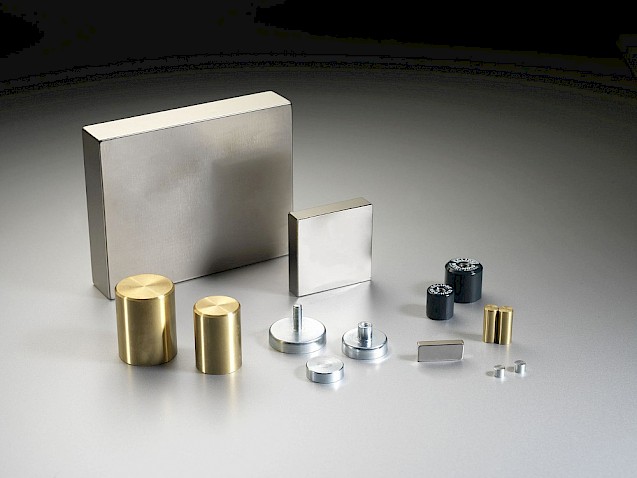Neodymium NdFeb Shallow Pot Magnets with Countersunk Hole
Easy to mount with screw fixings
Hello...
Would you like to visit the Eclipse Magnetics US site to view all relevant content for your location?

Neodymium magnets (also known as "NdFeB", "Neo" or "NIB" magnets) are permanent magnets made of neodymium, iron & boron. They are from the Rare-Earth magnet family and have the highest magnetic properties of all permanent magnets, stronger than Samarium Cobalt (SmCo), Alnico and Ferrite. In addition to their high magnetic strength, they are relatively inexpensive, making them an ideal choice for a wide range of consumer, commercial, industrial and technical applications.
Neodymium magnets (NdFeB) offer a maximum performance from the smallest magnet volume. They should always be coated to guard against the risk of corrosion – NiCuNi, Zinc, NiCuEpoxy and Gold are popular finishes. There are 55 NdFeB magnets commonly in use. They are used in nearly all Industries: Automotive, Aerospace, Wind Turbine, Military, White Goods, Lighting, Food Preparation, Separation, Motor and Generator Industries are just a few example Industries.
What Grades and Shapes are available for Neodymium Magnets?
There are different grades of Neodymium magnets, for example N35, N38, N42, N38SH.. etc. Each type of Neodymium magnet is rated according to its material. Magnetic force increases with the magnet's grade (the number following the 'N'). Current high-grade neodymium magnets are N52. Any letter following the grade indicates the magnet's temperature rating. Magnets with no letters following the grade are neodymium standard temperature. So no letter on a standard neodymium magnet indicates its maximum operating temperature, 80⁰ C.
Our Neodymium magnets are all REACH and ROHS compliant. They do not contain any SVHC and the Neodymium is produced to ISO9001 and ISO14001 Quality Control Standards. NdFeB Neodymium magnets are usually supplied in blocks, discs, rings, arcs, spheres, triangles, trapezoids and many other shapes as stock and custom items. We also manufacture NdFeB magnet assemblies.
The most appropriate temperature for Neodymium Magnets
The performance of a neodymium magnet is affected by temperature. As the temperature gets colder, neodymium magnets get stronger, and they even operate better at lower temperatures. Neodymium magnets are said to be able to function well in temperatures as low as -130 ° C. It is also possible for certain grades of neodymium magnets to be exposed to very high temperatures before they begin to change their properties and, either temporarily or permanently, lose their magnetism.
Neodymium Magnets decrease in magnetic strength by 0.11% for every degree celsius of temperature increase. If the maximum operating temperature is not exceeded, this small loss can be fully recovered on cooling. In the case of exceeding it, the small loss will not be recovered on cooling. The magnetic field output of Neodymium magnets increases with temperature up to 80° C and after that point, they begin to lose their effectiveness. There are different levels of Neodymium 35 temperature rating (M, H, SH, UH, EH, or AH). Higher temperature versions (NxxM, NxxH, NxxSH, NxxUH, NxxEH, NxxVH/AH) are rated from up to +100⁰ C to a maximum of up to +230 ⁰ C. The magnetic performance will continue to decline after successive hot-cold cycles. Without careful design of the magnetic circuit, you should not use these magnets in temperatures above 130° C (240° F).
The permanent demagnetisation fields and radiation can also affect neodymium magnets, so the magnet must always be fully understood according to the environment in which it will be used.
Neodymium Magnets require surface treatments
In humid conditions, magnets without a surface coating (such as plating) may rust. Therefore, all Neodymium Magnets or Rare Earth magnets should have some form of protective coating to minimise and ideally prevent corrosion. Uncoated is not advised. The default / standard protective coating is Ni−Cu−Ni plating. Other coatings/finishes exist (over 40 finishes are currently available). Where maximum corrosion resistance is required for NdFeB, consider using the increased corrosion resistance range of NdFeB alloys.
Advantages
Disadvantages

Neodymium magnets are available in several different sizes and variations, including neodymium bar magnets or neodymium blocks, neodymium disc magnets, neodymium pot magnets, neodymium ring magnets. They are also available with attachments such as hooks or threaded attachments. They are also available with rubber coatings or adhesive backings. This gives a vast choice to suit a variety of applications including:-
Example: An automotive company required a thin disc shaped magnetic clamp to hold two mild steel sections together with maximum force. Even high-grade Neodymium NdFeB disc and ring magnets did not provide enough pull strength performance. Our solution was a dual polarity Neodymium (NdFeB) disc magnet within a ring assembly creating a perfect magnetic circuit with a pull force meeting the specification.